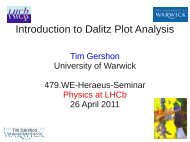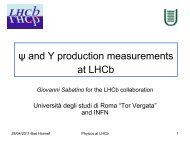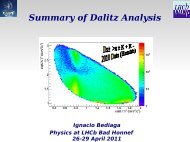Use of binned Dalitz plots to measure at LHCb - Physics at LHCb
Use of binned Dalitz plots to measure at LHCb - Physics at LHCb
Use of binned Dalitz plots to measure at LHCb - Physics at LHCb
You also want an ePaper? Increase the reach of your titles
YUMPU automatically turns print PDFs into web optimized ePapers that Google loves.
<strong>Physics</strong> <strong>at</strong> <strong>LHCb</strong>, Bad Honnef, 28 th April 2011<strong>Use</strong> <strong>of</strong> <strong>binned</strong> <strong>Dalitz</strong> <strong>plots</strong> <strong>to</strong> <strong>measure</strong> γ <strong>at</strong><strong>LHCb</strong>Daniel Johnson, Sneha Malde, Guy WilkinsonUniversity <strong>of</strong> Oxford<strong>Physics</strong> <strong>at</strong> <strong>LHCb</strong>, Bad Honnef28 th April 2011D. Johnson γ in <strong>binned</strong> <strong>Dalitz</strong> analyses <strong>at</strong> <strong>LHCb</strong> 1 / 16
<strong>Physics</strong> <strong>at</strong> <strong>LHCb</strong>, Bad Honnef, 28 th April 2011Outline1 γ determin<strong>at</strong>ion in B ± → DK ±2 Multibody D 0 final st<strong>at</strong>es3 D 0 phase inform<strong>at</strong>ion from CLEO-cSelf-conjug<strong>at</strong>e final st<strong>at</strong>esNon self-conjug<strong>at</strong>e final st<strong>at</strong>es4 St<strong>at</strong>us <strong>of</strong> analyses <strong>at</strong> <strong>LHCb</strong>Expected impact on γ precisionD. Johnson γ in <strong>binned</strong> <strong>Dalitz</strong> analyses <strong>at</strong> <strong>LHCb</strong> 2 / 16
<strong>Physics</strong> <strong>at</strong> <strong>LHCb</strong>, Bad Honnef, 28 th April 2011Measuring γ using B ± → D 0 ( ¯D 0 )K ±<strong>Use</strong> interference between b → c and b → u processes:(a) B − → D 0 K −(b) B − → ¯D 0 K −Yields for the B − (or B + ) decays sensitive <strong>to</strong> γ = arg( V ∗ubV ∗ cb)B − D 0r Be i(δB−γ)D 0r D e −iδDFr B e i(δ B−γ) = A B − → ¯D 0 K −A B − →D 0 K −and similarly for D decayparameters, r D and δ DD. Johnson γ in <strong>binned</strong> <strong>Dalitz</strong> analyses <strong>at</strong> <strong>LHCb</strong> 3 / 16
<strong>Physics</strong> <strong>at</strong> <strong>LHCb</strong>, Bad Honnef, 28 th April 2011Multibody D 0 final st<strong>at</strong>esIncrease st<strong>at</strong>istical power by combining multibody modes with 2-body B → (hh ′ ) D KModeB ± → (K ± π ∓ ) D K ±Self-conjug<strong>at</strong>e multibodyB ± → (K 0 S π± π ∓ ) D K ±B ± → (K 0 S K ± K ∓ ) D K ±ADS-style multibodyB ± → (K ± π ∓ π ± π ∓ ) D K ±B ± → (K ± π ∓ π 0 ) D K ±B ± → (K 0 S K ± π ∓ ) D K ±an extra hurdle in multibody decays:D 0B − r FBe i(δB−γ)r D e −iδDD 0r D and δ D vary over <strong>Dalitz</strong> spaceRequire either:1 Phase info from amplitude model3 ◦ → 9 ◦ γ uncertainty or2 Determine averages <strong>of</strong> the varyingparameters using externalinform<strong>at</strong>ion from CLEO-c→ model independentD. Johnson γ in <strong>binned</strong> <strong>Dalitz</strong> analyses <strong>at</strong> <strong>LHCb</strong> 4 / 16
<strong>Physics</strong> <strong>at</strong> <strong>LHCb</strong>, Bad Honnef, 28 th April 2011Measuring D decay parameters <strong>at</strong> CLEO-cStrong phase differences in <strong>Dalitz</strong> space bins can be determinedusing quantum correl<strong>at</strong>ed (Q.C.) decays:(a) Q.C. samples (CP tags: KK , K 0 Sπ 0 ...) (b) MC: D CP− → K ππ 0Event density in <strong>Dalitz</strong> plot ∝ |D 0 | 2 + | ¯D 0 | 2 ± 2|D 0 || ¯D 0 |cos δ⇒Accessing strong phase differences a counting experimentD. Johnson γ in <strong>binned</strong> <strong>Dalitz</strong> analyses <strong>at</strong> <strong>LHCb</strong> 5 / 16
<strong>Physics</strong> <strong>at</strong> <strong>LHCb</strong>, Bad Honnef, 28 th April 2011Binned approach: self-conjug<strong>at</strong>e final st<strong>at</strong>esThe fit for γThe number <strong>of</strong> B events in bins 1 (N ± i) <strong>of</strong> the <strong>Dalitz</strong> space dependson γ and other quantities:N ± i= h(K ±i + r 2 BK ∓i + 2 √ K i K −i [x ± c i ± y ± s i ]K ±i - number <strong>of</strong> events for flavour tagged D samplex ± = r B cos(δ B ± γ), y ± = r B sin(δ B ± γ)c i and s i are average <strong>of</strong> cosine/sine <strong>of</strong> strong phase difference, overthe binMeasuring c i and s i <strong>at</strong> CLEO-cReconstruct ‘double tags’ (e.g. D 1 → K S ππ and D 2 →CP) then simplycount yields in <strong>Dalitz</strong> bins.e.g. Yield(bin ±i) ∝ K i ± 2c i√Ki K −i + K −i1 PRD 68 054018 (2003) and EPJ C 55 (2008) 51D. Johnson γ in <strong>binned</strong> <strong>Dalitz</strong> analyses <strong>at</strong> <strong>LHCb</strong> 6 / 16
<strong>Physics</strong> <strong>at</strong> <strong>LHCb</strong>, Bad Honnef, 28 th April 2011Binned approach: self-conjug<strong>at</strong>e final st<strong>at</strong>esHow <strong>to</strong> choose the bins?Binning events reduces st<strong>at</strong>istical sensitivity compared <strong>to</strong>un<strong>binned</strong>Intelligent choice <strong>of</strong> bins improves the situ<strong>at</strong>ionOptimally choose bins 2 ...around regions <strong>of</strong> expected similar strong phase differenceaccounting for expected B st<strong>at</strong>istics distributiongiven <strong>LHCb</strong> background shapes in <strong>Dalitz</strong> plot⇒ lose only 10% <strong>of</strong> st<strong>at</strong>istical sensitivity compared <strong>to</strong> un<strong>binned</strong>approach2 PRD 82, 112006 (2010)D. Johnson γ in <strong>binned</strong> <strong>Dalitz</strong> analyses <strong>at</strong> <strong>LHCb</strong> 7 / 16
<strong>Physics</strong> <strong>at</strong> <strong>LHCb</strong>, Bad Honnef, 28 th April 2011Results: c i , s i for K 0 S ππResults for 〈cos δ D 〉 and 〈sin δ D 〉, different binning choices 3 :Encouraging <strong>to</strong> see BaBar model agrees with d<strong>at</strong>a3 PRD 82, 112006 (2010)D. Johnson γ in <strong>binned</strong> <strong>Dalitz</strong> analyses <strong>at</strong> <strong>LHCb</strong> 8 / 16
<strong>Physics</strong> <strong>at</strong> <strong>LHCb</strong>, Bad Honnef, 28 th April 2011Results: c i , s i for K 0 S KKResults for 〈cos δ D 〉 and 〈sin δ D 〉, different binning choices 4 :4 PRD 82, 112006 (2010)D. Johnson γ in <strong>binned</strong> <strong>Dalitz</strong> analyses <strong>at</strong> <strong>LHCb</strong> 9 / 16
<strong>Physics</strong> <strong>at</strong> <strong>LHCb</strong>, Bad Honnef, 28 th April 2011<strong>LHCb</strong>: System<strong>at</strong>ic uncertainty on γ from strong phaseBinned approachThe dominant system<strong>at</strong>ic uncertainty in the <strong>binned</strong> approach comesfrom uncertainties on c i and s i from the CLEO <strong>measure</strong>ment1.7 → 3.9 ◦ for KS 0 ππ (depends on binning choice)3.2 → 3.9 ◦ for KS 0 KK (depends on binning choice)Un<strong>binned</strong> approachModelling system<strong>at</strong>ic in the un<strong>binned</strong> approach: 3 → 9 ◦Similar uncertainty, but <strong>binned</strong> approach system<strong>at</strong>ics origin<strong>at</strong>efrom experimentally <strong>measure</strong>d quantities onlyD. Johnson γ in <strong>binned</strong> <strong>Dalitz</strong> analyses <strong>at</strong> <strong>LHCb</strong> 10 / 16
<strong>Physics</strong> <strong>at</strong> <strong>LHCb</strong>, Bad Honnef, 28 th April 2011<strong>LHCb</strong>: KS 0ππ/K S 0 KK st<strong>at</strong>usCurrent st<strong>at</strong>us <strong>at</strong> <strong>LHCb</strong> in 2010 d<strong>at</strong>a: clear signals in control modesEvents / ( 20 MeV )Events / ( 20 MeV )180160140120100806040200302520151050B ± ! D 0 (K 0 " ± " # ) " ±S<strong>LHCb</strong>Preliminarys = 7 TeV D<strong>at</strong>a-1L int = 33.9 ± 3.4 pbN Signal = 443 ± 32m 0 = 5271.8 ± 1.5 MeV! = 23.5 ± 1.6 MeV5200 5400 5600±Bmass (MeV)B ± ! D 0 (K 0 K ± K # ) " ±S<strong>LHCb</strong>Preliminarys = 7 TeV D<strong>at</strong>aD<strong>at</strong>aReco 06 Stripping 10 (mag down) and Reco 07 Stripping 11 (mag up)‘B2DXWithD2Kshh’ stripping lineSelectionTracksAll 5 tracks: track $ 2 < 5VerticesD: vertex $ 2 /d<strong>of</strong> 25(LL) >16(DD)D 0 : PT > 1.5 GeVBachelor: PT > 1 GeVB: Lifetime > 0.2 ps: Pointing angle > 0.9998MassK 0 S window: 15 MeV(LL) 21 MeV(DD)D 0 window: 25 MeV(LL) 40 MeV(DD)PID - K 0 KK onlyD 0 SThese are the mostpions: PID (K - ") > 5important cuts-1pb= 33.9 ± 3.4 L intN Signal = 78.4 ± 9.6Fitm 0 = 5270.9 ± 2.1 MeV! = 22.3 ± 2.2 MeVLow mass PDF:K 0 S"" - gaussian tail, flo<strong>at</strong>ing mean and widthK 0 SKK - exponential, flo<strong>at</strong>ing coefficientSignal PDF: single gaussian5200 5400 5600 High mass PDF: linear±Bmass (MeV)Daniel Johnson, 25/11/2010D. Johnson γ in <strong>binned</strong> <strong>Dalitz</strong> analyses <strong>at</strong> <strong>LHCb</strong> 11 / 16
<strong>Physics</strong> <strong>at</strong> <strong>LHCb</strong>, Bad Honnef, 28 th April 2011<strong>LHCb</strong>: KS 0ππ/K S 0 KK analysisAnalysis methodBin the <strong>LHCb</strong> d<strong>at</strong>a for B + → DK + and B − → DK − in D 0 <strong>Dalitz</strong> spaceCorrect for <strong>LHCb</strong> acceptance, PID efficiencies, production/detectionasymmetriesMeasure γ via fit <strong>to</strong> B + , B − r<strong>at</strong>ios in bins <strong>of</strong> <strong>Dalitz</strong> space<strong>LHCb</strong> Acceptance for B ± → DK ±<strong>Use</strong> B ± → Dπ ± as control mode, since r Dπ ∼ 0.01 so CP viol<strong>at</strong>ion negligibleCompare <strong>to</strong> BaBar model 5 (models <strong>Dalitz</strong> distribution well) <strong>to</strong> extract efficienciesSystem<strong>at</strong>ics: bachelor kinem<strong>at</strong>ics, bachelor PID, efficiency vari<strong>at</strong>ion within bins5 Phys. Rev. Lett. 105, 081803 (2010)D. Johnson γ in <strong>binned</strong> <strong>Dalitz</strong> analyses <strong>at</strong> <strong>LHCb</strong> 12 / 16
<strong>Physics</strong> <strong>at</strong> <strong>LHCb</strong>, Bad Honnef, 28 th April 2011Binned approach: non self-conjug<strong>at</strong>e final st<strong>at</strong>esThe fit for γF=(2 body), decay r<strong>at</strong>e:D 0B − rBei(δB−γ) rDe −iδDD 0FΓ(B + → (K + π − ) D K + ) ∝ 1 + (r B r D ) 2 + 2r B r D cos(δ B + γ − δ K π )F=Multibody, integr<strong>at</strong>e equivalent expression over the <strong>Dalitz</strong> spaceΓ(B + → (K + πππ) D K + ) ∝ 1+(r B r D ) 2 +2r B r D R K πππ cos(δ B +γ−δ K πππ )Rwhere R K πππ e iδ dxAD 0 (x)A ¯K πππ = (x) D0A D 0 A ¯ D0(coherence fac<strong>to</strong>r and avg. strong phase difference)Measure R F and δ F <strong>at</strong> CLEO-cAgain, count yields <strong>of</strong> ‘double tag’ events <strong>at</strong> CLEO-ceg:CP tag vs F⇒ R F cos(δ F ), F vs F ⇒ R 2 F , (K π) vs F ⇒ R F cos(δ F − δ K π )D. Johnson γ in <strong>binned</strong> <strong>Dalitz</strong> analyses <strong>at</strong> <strong>LHCb</strong> 13 / 16
<strong>Physics</strong> <strong>at</strong> <strong>LHCb</strong>, Bad Honnef, 28 th April 2011Results: coherence fac<strong>to</strong>rs/avg strong phase diff’s22K ππ 0 : high coherenceR K ππ 0 = 0.84 ± 0.07δ K ππ 0 = (227 +14−17 )◦⇒<strong>Use</strong>ful for ADS γK πππ: low coherence aR K ππ 0 = 0.33 +0.26−0.23⇒better r B knowledgePRD 80, 031105 (2009)D→ K K - π +S)2(GeVinvar mπ +0K S01.81.61.41.210.80.60.4Bin 10Bin 2Bin 2Entries 14131 1.5 2 2.5 30 -2 2K S K invar m (GeV )20181614121086420)2(GeVinvar mπ -0K S021.81.61.41.210.80.60.40+-D→ K SKπBin 1Bin 2Bin 21 1.5 2 2.5 3Entries 8050 +2 2K S K invar m (GeV )109876543210KS 0 K π: preliminaryFull <strong>Dalitz</strong>R K ππ 0 = 0.73 ± 0.09δ K ππ 0 = (8.2 ± 15.2) ◦Bin 1R K ππ 0 = 0.96 ± 0.17δ K ππ 0 = (25.8 ± 17.3) ◦D. Johnson γ in <strong>binned</strong> <strong>Dalitz</strong> analyses <strong>at</strong> <strong>LHCb</strong> 14 / 16
<strong>Physics</strong> <strong>at</strong> <strong>LHCb</strong>, Bad Honnef, 28 th April 2011<strong>LHCb</strong>: K 3π/K 0 S K π/K ππ0 st<strong>at</strong>usSignal (CF) in B → (K πππ) D K in 2010 d<strong>at</strong>a:Expected γ precision using ADS modes (excluding K ππ 0 ) in 2 fb −1 :D. Johnson γ in <strong>binned</strong> <strong>Dalitz</strong> analyses <strong>at</strong> <strong>LHCb</strong> 15 / 16
<strong>Physics</strong> <strong>at</strong> <strong>LHCb</strong>, Bad Honnef, 28 th April 2011ConclusionsSummary:Multi-body <strong>LHCb</strong> analyses increase st<strong>at</strong>istical power <strong>of</strong> γ <strong>measure</strong>mentBinning <strong>Dalitz</strong> space allows model independence with phaseinform<strong>at</strong>ion derived from D 0 <strong>measure</strong>ments <strong>at</strong> CLEO-cself-conjug<strong>at</strong>e: KS 0ππ and K S 0KKADS-style: K πππ, KS 0 K π and K ππ0Limiting system<strong>at</strong>ic origin<strong>at</strong>es from experimentally <strong>measure</strong>d quantities<strong>at</strong> CLEO-c (scope <strong>to</strong> reduce further <strong>at</strong> BES III)D. Johnson γ in <strong>binned</strong> <strong>Dalitz</strong> analyses <strong>at</strong> <strong>LHCb</strong> 16 / 16







